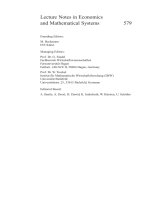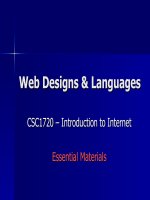Lecture no22 design economics
Bạn đang xem bản rút gọn của tài liệu. Xem và tải ngay bản đầy đủ của tài liệu tại đây (732.96 KB, 12 trang )
Design Economics
Lecture No. 22
Chapter 6
Contemporary Engineering Economics
Copyright © 2016
Contemporary Engineering Economics, 6 th edition
Park
Copyright © 2016 by Pearson Education, Inc.
All Rights Reserved
Minimum Cost Analysis
Concept: Total cost is given in terms of a specific
design parameter.
Goal: Find the optimal design parameter that
will minimize the total cost.
Typical Mathematical Equation
AE(i) a bx
c
x
where x is the common design parameter
Analytical Solution
c
x
b
*
Contemporary Engineering Economics, 6 th edition
Park
Copyright © 2016 by Pearson Education, Inc.
All Rights Reserved
Typical Graphical Relationship
Total Cost
Capital Cost
Cost ($)
O&M Cost
Design Parameter (x)
Optimal Value (x*)
Contemporary Engineering Economics, 6 th edition
Park
Copyright © 2016 by Pearson Education, Inc.
All Rights Reserved
Example 6.11: Optimal Cross-Sectional
Area
Decision Problem: A constant
• Power Transmission
electric current of 5,000 amps is
to be transmitted a distance of
1,000 feet from a power station
to a substation.
Find: The optimal size of a
copper conductor
Relevant Physical and Financial
Data:
•Copper price: $8.25/lb
•Resistance: 0.8145x10-5Ωin2/f
•Cost of energy: $0.05/kWh
•Density of copper: 555 lb/f
1,000 ft.
•Useful life: 25 years
5,000 amps
•Salvage value: $0.75/lb
24 hours
•Interest rate: 9%
365 days
Cross-sectional area
Contemporary Engineering Economics, 6 th edition
Park
Copyright © 2016 by Pearson Education, Inc.
All Rights Reserved
Operating Cost (Energy Loss)
• Energy loss in kilowatt-hours (L)
I = current flow in
amperes
R = resistance in ohms
T = number of operating
5 0 0 0 2 ( 0 . 0 0 8 hours
1 4 5)
L
�3 6 5 )
A (2
= 4cross-sectional
area
1000 A
1 ,7 83 ,7 55
kW h
A
1,783,755
E n e rg y lo ss co st
k W h ($ 0 .0 5 )
A
$ 8 9 ,1 8 8
=
A
I 2R
L
T
1000 A
Contemporary Engineering Economics, 6 th edition
Park
Copyright © 2016 by Pearson Education, Inc.
All Rights Reserved
Material Costs
• Material weight in pounds
1000(12)(555) A
3,854 A
3
12
• Material cost (required
investment)
Total material cost =
3,854A($8.25)
=
31,797A
• Salvage value after 25 years:
Contemporary Engineering Economics, 6 th edition
Park
Copyright © 2016 by Pearson Education, Inc.
All Rights Reserved
Capital Recovery Cost
Given:
Initial cost =
$31,797A
Salvage value =
$2,890.6A
Project life = 25
years
Interest rate = 9%
2,890.6 A
0
25
31,797 A
CR(9%) = (31,797 A - 2,890.6A) (A/P, 9%, 25)
Find: CR(9%)
+ 2,890.6A (0.09)
= 3,203 A
Contemporary Engineering Economics, 6 th edition
Park
Copyright © 2016 by Pearson Education, Inc.
All Rights Reserved
Total Equivalent Annual Cost
• Total equivalent annual cost
AEC = Capital cost + Operating cost
= Material cost + Energy loss
• Find the minimum annual equivalent cost
8 9 ,1 8 8
A
dA E C (9% )
8 9 ,1 8 8
3, 2 0 3
dA
A2
0
A E C ( 9 % ) 3, 2 0 3 A
A*
8 9 ,1 8 8
3, 2 0 3
5 .2 7 6 in 2
Contemporary Engineering Economics, 6 th edition
Park
Copyright © 2016 by Pearson Education, Inc.
All Rights Reserved
Contemporary Engineering Economics, 6 th edition
Park
Copyright © 2016 by Pearson Education, Inc.
All Rights Reserved
Optimal Cross-Sectional Area
Contemporary Engineering Economics, 6 th edition
Park
Copyright © 2016 by Pearson Education, Inc.
All Rights Reserved
Summary
•
•
•
•
Annual equivalent worth analysis, or AE, is—along with present
worth analysis—one of two main analysis techniques based on
the concept of equivalence. The equation for AE is:
AE(i) = PW(i)(A/P, i, N)
AE analysis yields the same decision result as PW analysis.
The capital recovery cost factor, or CR(i), is one of the most
important applications of AE analysis in that it allows managers
to calculate an annual equivalent cost of capital for ease of
itemization with annual operating costs.
The equation for CR(i) is:
CR(i)= (I − S)(A/P, i, N) + iS
•
where I = initial cost and S = salvage value.
Contemporary Engineering Economics, 6 th edition
Park
Copyright © 2016 by Pearson Education, Inc.
All Rights Reserved
•
AE analysis is recommended over NPW analysis in many
key real-world situations for the following reasons:
1. In many financial reports, an annual equivalent value is
preferred to a present worth value.
2. Unit costs often must be calculated to determine reasonable
pricing for items that are on sale.
3. Calculation of cost per unit of use is required to reimburse
employees for business use of personal cars.
4. Make-or-buy decisions usually require the development of
unit costs for the various alternatives.
5. Minimum cost analysis is easy to do when based on annual
equivalent worth.
Contemporary Engineering Economics, 6 th edition
Park
Copyright © 2016 by Pearson Education, Inc.
All Rights Reserved









